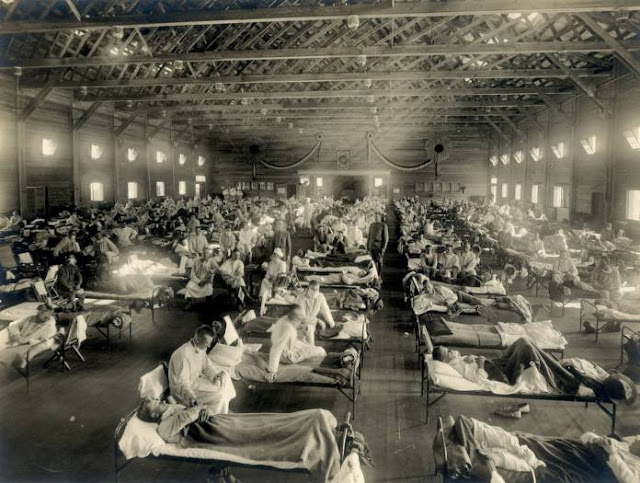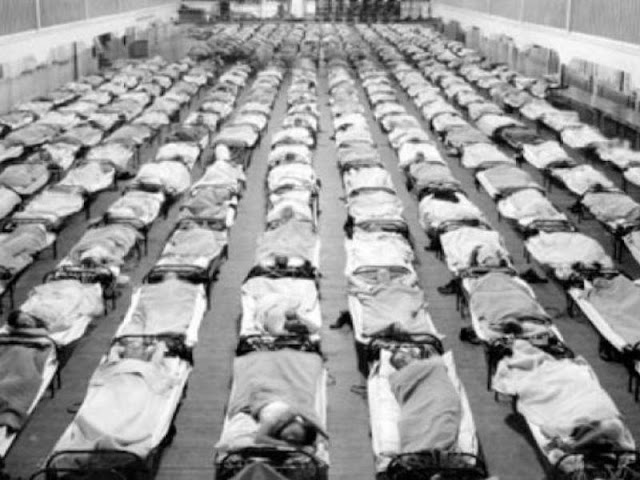History
Coronavirus Coverage
March 27, 2020
How some cities ‘flattened the curve’ during the 1918 flu pandemic
Social distancing isn’t a new idea—it saved thousands of American lives during the last great pandemic. Here's how it worked.
By Nina Strochlic and Riley D. Champine
Social distancing isn’t a new idea—it saved thousands of American lives during the last great pandemic. Here's how it worked.
By Nina Strochlic and Riley D. Champine
Philadelphia
detected its first case of a deadly, fast-spreading strain of influenza
on September 17, 1918. The next day, in an attempt to halt the virus’
spread, city officials launched a campaign against coughing, spitting,
and sneezing in public. Yet 10 days later—despite the prospect of an
epidemic at its doorstep—the city hosted a parade that 200,000 people
attended.
Flu cases continued to mount until finally, on October 3, schools, churches, theaters, and public gathering spaces were shut down. Just two weeks after the first reported case, there were at least 20,000 more.
The 1918 flu, also known as the Spanish Flu, lasted until 1920 and is considered the deadliest pandemic in modern history. Today, as the world grinds to a halt in response to the coronavirus,
scientists and historians are studying the 1918 outbreak for clues to
the most effective way to stop a global pandemic. The efforts
implemented then to stem the flu’s spread in cities across America—and
the outcomes—may offer lessons for battling today’s crisis. (Get the latest facts and information about COVID-19.)
From its first known U.S. case,
at a Kansas military base in March 1918, the flu spread across the
country. Shortly after health measures were put in place in
Philadelphia, a case popped up in St. Louis. Two days later, the city
shut down most public gatherings and quarantined victims in their homes.
The cases slowed. By the end of the pandemic, between 50 and 100
million people were dead worldwide, including more than 500,000
Americans—but the death rate in St. Louis was less than half of the rate
in Philadelphia. The deaths due to the virus were estimated
to be about 358 people per 100,000 in St Louis, compared to 748 per
100,000 in Philadelphia during the first six months—the deadliest
period—of the pandemic.
Dramatic demographic shifts in the past century have made containing a
pandemic increasingly hard. The rise of globalization, urbanization,
and larger, more densely populated cities can facilitate a virus’ spread
across a continent in a few hours—while the tools available to respond
have remained nearly the same. Now as then, public health interventions
are the first line of defense against an epidemic in the absence of a
vaccine. These measures include closing schools, shops, and restaurants;
placing restrictions on transportation; mandating social distancing,
and banning public gatherings. (This is how small groups can save lives during a pandemic.)
Of course, getting citizens to comply with such orders is another story: In 1918, a San Francisco health officer shot three people
when one refused to wear a mandatory face mask. In Arizona, police
handed out $10 fines for those caught without the protective gear. But
eventually, the most drastic and sweeping measures paid off. After
implementing a multitude of strict closures and controls on public
gatherings, St. Louis, San Francisco, Milwaukee, and Kansas City
responded fastest and most effectively: Interventions there were
credited with cutting
transmission rates by 30 to 50 percent. New York City, which reacted
earliest to the crisis with mandatory quarantines and staggered business
hours, experienced the lowest death rate on the Eastern seaboard.
In 2007, a study in the Journal of the American Medial Association
analyzed health data from the U.S. census that experienced the 1918
pandemic, and charted the death rates of 43 U.S. cities. That same year,
two studies published in the Proceedings of the National Academy of Sciences
sought to understand how responses influenced the disease’s spread in
different cities. By comparing fatality rates, timing, and public health
interventions, they found death rates were around 50 percent lower in
cities that implemented preventative measures early on, versus those
that did so late or not at all. The most effective efforts had
simultaneously closed schools, churches, and theaters, and banned public
gatherings. This would allow time for vaccine development (though a flu vaccine was not used until the 1940s) and lessened the strain on health care systems.
The studies reached another important conclusion: That relaxing
intervention measures too early could cause an otherwise stabilized city
to relapse. St. Louis, for example, was so emboldened by its low death
rate that the city lifted restrictions on public gatherings less than
two months after the outbreak began. A rash of new cases soon followed.
Of the cities that kept interventions in place, none experienced a
second wave of high death rates. (See photos that capture a world paused by coronavirus.)
In 1918, the studies
found, the key to flattening the curve was social distancing. And that
likely remains true a century later, in the current battle against
coronavirus. “[T]here is an invaluable treasure trove of useful
historical data that has only just begun to be used to inform our
actions,” Columbia University epidemiologist Stephen S. Morse wrote in an analysis of the data. “The lessons of 1918, if well heeded, might help us to avoid repeating the same history today.”
Nina Strochlic is a staff writer covering culture for National Geographic.
Follow Nina
Fonte: National Geographic,
STROCHLIC, N. & CHAMPIRE, R. D. (2020). How some cities ‘flattened the curve’ during the 1918 flu pandemic. National Geographic, March 27, 2020. History, Coronavirus Coverage. National Geographic Society.







Nenhum comentário:
Postar um comentário
Não serão aceitos comentários ofensivos, preconceituosos, racistas ou qualquer forma de difamação.